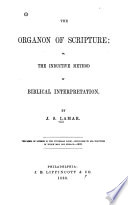 ... attracts every other particle with a force proportional to the product of the masses and inversely proportional to the square of the distance between them. ... attracts every other particle with a force proportional to the product of the masses and inversely proportional to the square of the distance between them.  The Fundamentals of Astronomy - Page 90by Samuel Alfred Mitchell, Charles Greeley Abbot - 1927 - 307 pagesFull view The Fundamentals of Astronomy - Page 90by Samuel Alfred Mitchell, Charles Greeley Abbot - 1927 - 307 pagesFull view - About this book
 | James Sanford Lamar - Bible - 1860 - 336 pages
...he arrived at a still more general conclusion, namely, that every particle of matter in the universe attracts every other particle with a force proportional to the product of their masses directly, and the square of their mutual distance inversely, and is itself attracted with... | |
 | Balfour Stewart - 1875 - 244 pages
...mass \ This question was answered by Newton, who came to the conclusion that every particle of matter attracts every other particle with a force proportional to the product of their masses, and inversely proportional to the square of their distances. But this only drives the... | |
 | Balfour Stewart - 1875 - 270 pages
...mass ? This question was answered by Newton, who came to the conclusion that every particle of matter attracts every other particle with a force proportional to the product of their masses, and inversely proportional to the square of their distances. But this only drives the... | |
 | Balfour Stewart, Peter Guthrie Tait - History - 1875 - 228 pages
...mass ? This question was answered by Newton, who came to the conclusion that every particle of matter attracts every other particle with a force proportional to the product of its mass, and inversely proportional to the square of its distance. But this only drives the mystery... | |
 | Balfour Stewart, Peter Guthrie Tait - Cosmology - 1875 - 274 pages
...mass 1 This question was answered by Newton, who came to the conclusion that every particle of matter attracts every other particle with a force proportional to the product of their masses, and inversely proportional to the square of their distances. But this only drives the... | |
 | Joel Dorman Steele - Physics - 1878 - 324 pages
...general law, one operation of an ever-active force. For every particle of matter in the universe * attracts every other particle with a force proportional to the product of their masses, and increasing as the square of the distance decreases. Gravitation is the general term... | |
 | Science - 1886 - 920 pages
...perfect identity with the Newtonian law of gravitation, according to which every particle of the universe attracts every other particle, with a force proportional to the product of the masses, and inversely as the square of the distance. Thus, the symmetry, beauty, and definiteness displayed... | |
 | Joel Dorman Steele - Physics - 1888 - 404 pages
...general law, one operation of an ever-active force. For every particle of matter in tlie tmiverse* attracts every other particle with a force proportional to the product of their masses, and increasing as the square of the distance decreases. Gravitation is the general term... | |
 | Joel Dorman Steele - Physics - 1889 - 368 pages
...a general law, one operation of an ever-active force. For every particle of matter in the universe attracts every other particle with a force proportional to the product of their masses, and increasing as the square of the distance decreases. The force of gravitation acts... | |
 | William McKendree Bryant - Force and energy - 1890 - 334 pages
...forcecenters, then, there will be a constant strain, tending to bring the bodies nearer to each other with a force proportional to the product of the masses of the two. That is, there will be a constant pull between each force-center in the one body, and every force-center... | |
| |